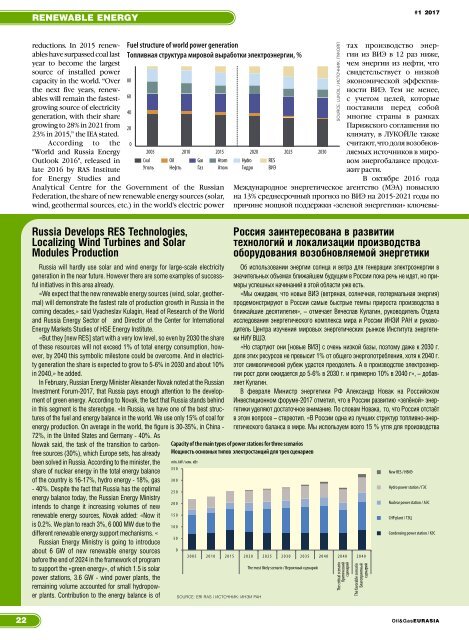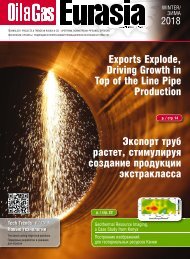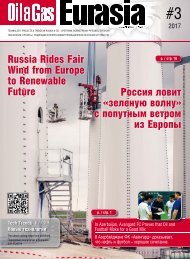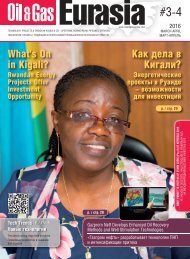Create successful ePaper yourself
Turn your PDF publications into a flip-book with our unique Google optimized e-Paper software.
RENEWABLE ENERGY<br />
<strong>#1</strong> <strong>2017</strong><br />
тах производство энергии<br />
из ВИЭ в 12 раз ниже,<br />
чем энергии из нефти, что<br />
свидетельствует о низкой<br />
экономической эффективности<br />
ВИЭ. Тем не менее,<br />
с учетом целей, которые<br />
поставили перед собой<br />
многие страны в рамках<br />
Парижского соглашения по<br />
климату, в ЛУКОЙЛе также<br />
считают, что доля возобновляемых<br />
источников в мировом<br />
энергобалансе продолжит<br />
расти.<br />
В октябре 2016 года<br />
Международное энергетическое агентство (МЭА) повысило<br />
на 13% среднесрочный прогноз по ВИЭ на 2015-2021 годы по<br />
причине мощной поддержки «зеленой энергетики» ключевыreductions.<br />
In 2015 renewables<br />
have surpassed coal last<br />
year to become the largest<br />
source of installed power<br />
capacity in the world. “Over<br />
the next five years, renewables<br />
will remain the fastestgrowing<br />
source of electricity<br />
generation, with their share<br />
growing to 28% in 2021 from<br />
23% in 2015,” the IEA stated.<br />
According to the<br />
"World and Russia Energy<br />
Outlook 2016", released in<br />
late 2016 by RAS Institute<br />
for Energy Studies and<br />
Analytical Centre for the Government of the Russian<br />
Federation, the share of new renewable energy sources (solar,<br />
wind, geothermal sources, etc.) in the world's electric power<br />
SOURCE: LUKOIL / ИСТОЧНИК: ЛУКОЙЛ<br />
Russia Develops RES Technologies,<br />
Localizing Wind Turbines and Solar<br />
Modules Production<br />
Russia will hardly use solar and wind energy for large-scale electricity<br />
generation in the near future. However there are some examples of successful<br />
initiatives in this area already.<br />
«We expect that the new renewable energy sources (wind, solar, geothermal)<br />
will demonstrate the fastest rate of production growth in Russia in the<br />
coming decades,» said Vyacheslav Kulagin, Head of Research of the World<br />
and Russia Energy Sector of and Director of the Center for International<br />
Energy Markets Studies of HSE Energy Institute.<br />
«But they [new RES] start with a very low level, so even by 2030 the share<br />
of these resources will not exceed 1% of total energy consumption, however,<br />
by 2040 this symbolic milestone could be overcome. And in electricity<br />
generation the share is expected to grow to 5-6% in 2030 and about 10%<br />
in 2040,» he added.<br />
In February, Russian Energy Minister Alexander Novak noted at the Russian<br />
Investment Forum-<strong>2017</strong>, that Russia pays enough attention to the development<br />
of green energy. According to Novak, the fact that Russia stands behind<br />
in this segment is the stereotype. «In Russia, we have one of the best structures<br />
of the fuel and energy balance in the world. We use only 15% of coal for<br />
energy production. On average in the world, the figure is 30-35%, in China -<br />
72%, in the United States and Germany - 40%. As<br />
Nowak said, the task of the transition to carbonfree<br />
sources (30%), which Europe sets, has already<br />
been solved in Russia. According to the minister, the<br />
share of nuclear energy in the total energy balance<br />
of the country is 16-17%, hydro energy - 18%, gas<br />
- 40%. Despite the fact that Russia has the optimal<br />
energy balance today, the Russian Energy Ministry<br />
intends to change it increasing volumes of new<br />
renewable energy sources, Novak added: «Now it<br />
is 0.2%. We plan to reach 3%, 6 000 MW due to the<br />
different renewable energy support mechanisms. «<br />
Russian Energy Ministry is going to introduce<br />
about 6 GW of new renewable energy sources<br />
before the end of 2024 in the framework of program<br />
to support the «green energy», of which 1.5 is solar<br />
power stations, 3.6 GW - wind power plants, the<br />
remaining volume accounted for small hydropower<br />
plants. Contribution to the energy balance is of<br />
SOURCE: ERI RAS / ИСТОЧНИК: ИНЭИ РАН<br />
Россия заинтересована в развитии<br />
технологий и локализации производства<br />
оборудования возобновляемой энергетики<br />
Об использовании энергии солнца и ветра для генерации электроэнергии в<br />
значительных объемах ближайшем будущем в России пока речь не идет, но примеры<br />
успешных начинаний в этой области уже есть.<br />
«Мы ожидаем, что новые ВИЭ (ветряная, солнечная, геотермальная энергия)<br />
продемонстрируют в России самые быстрые темпы прироста производства в<br />
ближайшие десятилетия», – отмечает Вячеслав Кулагин, руководитель Отдела<br />
исследования энергетического комплекса мира и России ИНЭИ РАН и руководитель<br />
Центра изучения мировых энергетических рынков Института энергетики<br />
НИУ ВШЭ.<br />
«Но стартуют они [новые ВИЭ] с очень низкой базы, поэтому даже к 2030 г.<br />
доля этих ресурсов не превысит 1% от общего энергопотребления, хотя к 2040 г.<br />
этот символический рубеж удастся преодолеть. А в производстве электроэнергии<br />
рост доли ожидается до 5-6% в 2030 г. и примерно 10% в 2040 г», – добавляет<br />
Кулагин.<br />
В феврале Министр энергетики РФ Александр Новак на Российском<br />
Инвестиционном форуме-<strong>2017</strong> отметил, что в России развитию «зелёной» энергетики<br />
уделяют достаточное внимание. По словам Новака, то, что Россия отстаёт<br />
в этом вопросе – стереотип. «В России одна из лучших структур топливно-энергетического<br />
баланса в мире. Мы используем всего 15 % угля для производства<br />
22<br />
Oil&<strong>Gas</strong>EURASIA











